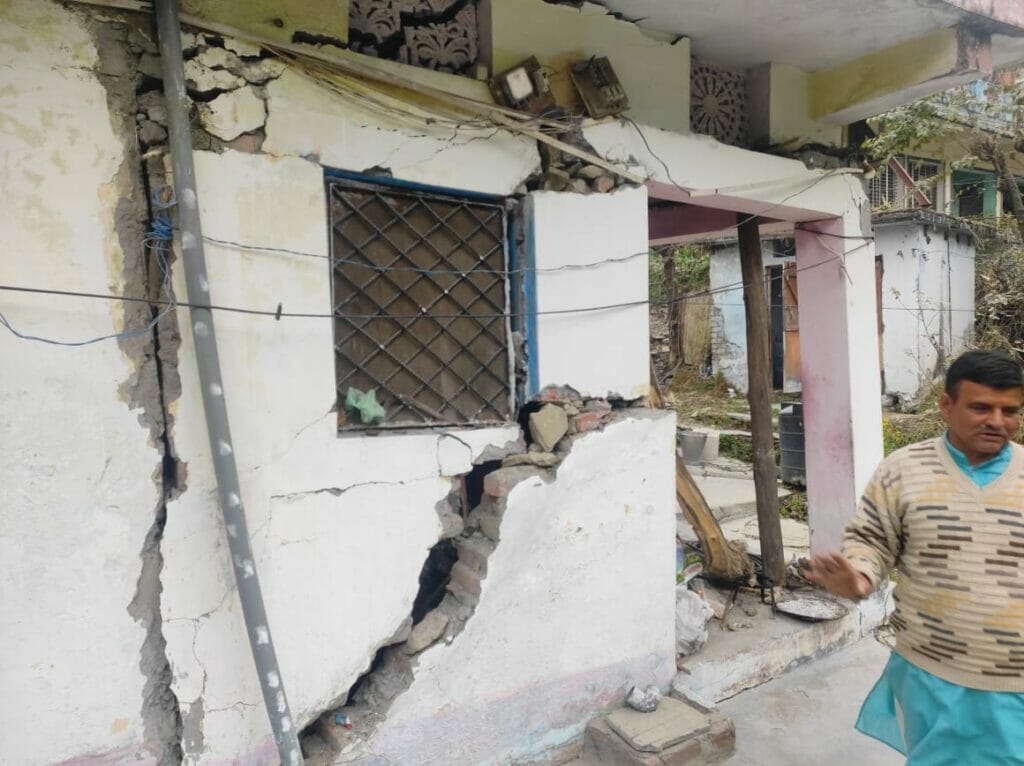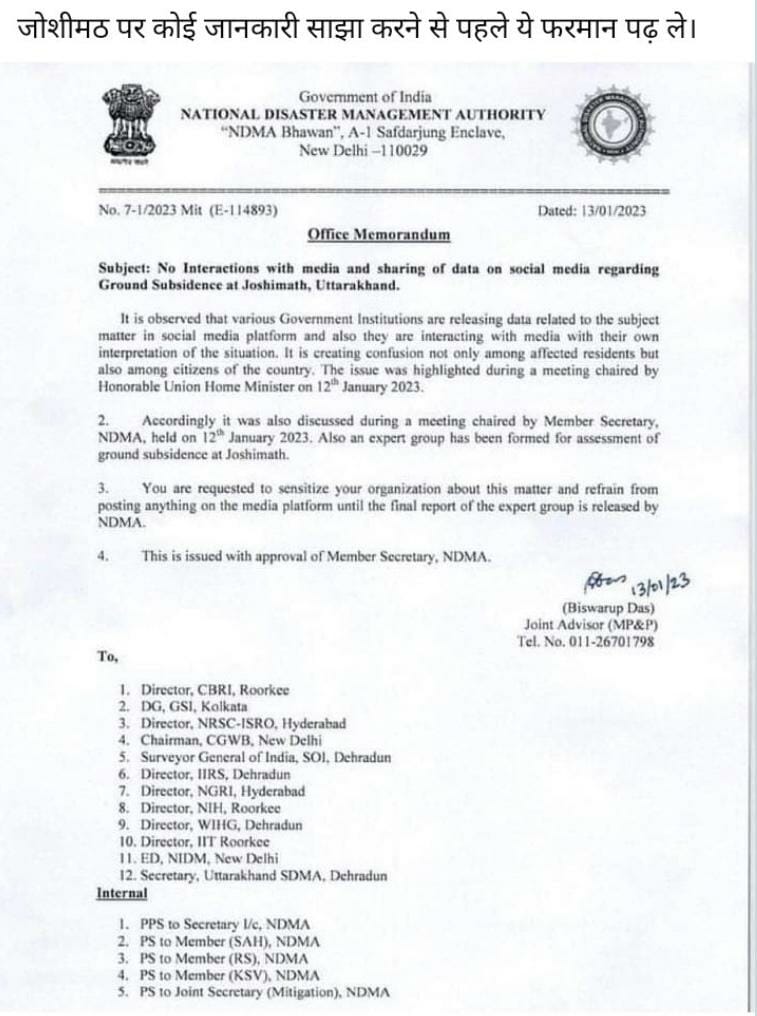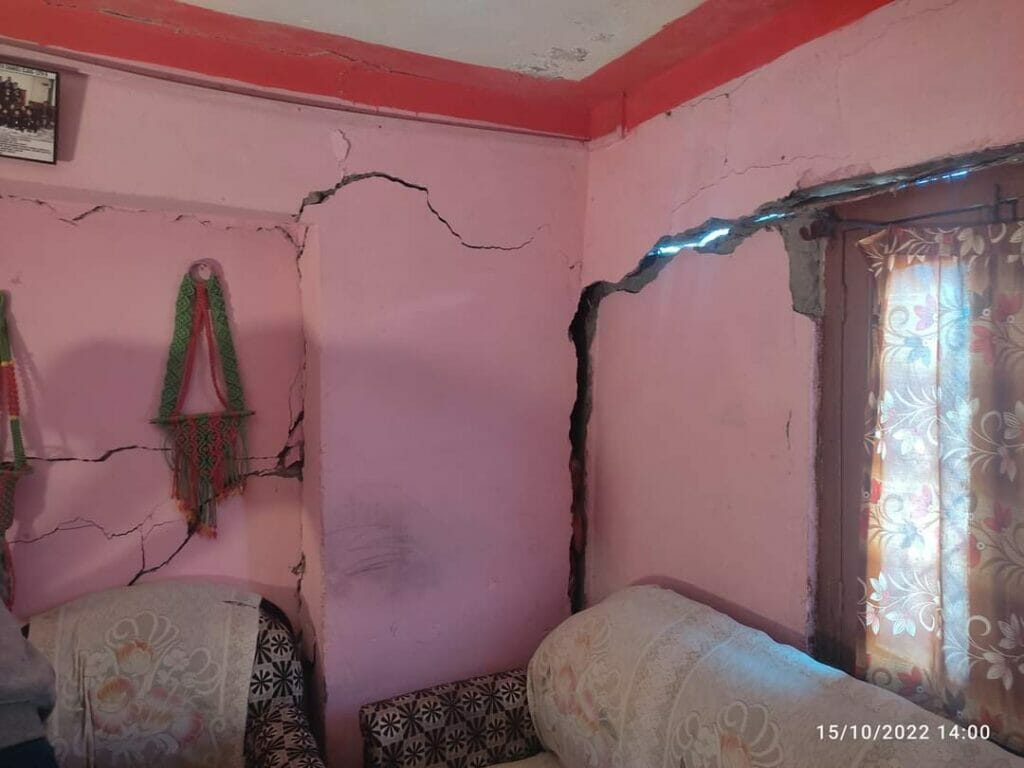This is the first of a two part story looking at the soil subsidence incidents in Joshimath and what the future holds for the affected residents
Probably for the first time in recent years, the 20,000 plus population of Joshimath, a picturesque town situated at a height of 6000 feet in the Garwal Himalayan foothills of Uttarakhand, prayed that there should not be any more rain and snow. But their prayers went unanswered. It did snow heavily in the past week, and the meteorological department offered no consolation with prediction of “heavy rain and snow from January 23rd till January 27th, in the Garhwal Himalayas,” according to Vikram Singh, Director of IMD, Uttarakhand.
To the people of the Joshimath, which according to ISRO satellite images, had sunk five inches in just 12 days in early January, the future looks extremely dire. Soil subsidence due to indiscriminate and unplanned construction and large infrastructure projects in its vicinity had caused part of the town to literally sink into the ground. The entire town’s population is literally shivering in cold and fear that they too could soon face a similar fate.
The dangers ahead for Joshimath residents
- Continuing rain and snow can enhance the rate of subsidence as percolation of water through cracks would further weaken the soil substructure.
- More areas of the town could be affected.
- Even the relief camps situated in the town could be hit by land subsidence.
- Coming summer and monsoon rains could further escalate subsidence and landslides.
- The trauma of losing hearths and homes and livelihood has resulted in mental agony and could lead to more psychological problems for the victims.
Hundreds of homes and other structures developed cracks and had started to lean over drunkenly. Many have now been marked for demolition and nearly a thousand residents evacuated to what has proved to be not much of a shelter at all. The beleaguered residents of Joshimath, some who have lived there for generations, now face permanent displacement and evacuation from their hearths, homes and livelihoods.

Read more: Opinion: A 10-point development agenda for a rapidly urbanising Uttarakhand
The same people, who even till last year, prayed for snow that would bring tourists flocking to the nearby winter sports centre of Auli and generate income for them. Auli, with its’ picturesque skiing slopes and ropeway, has now been totally shutdown following the Joshimath disaster. The ropeway between Joshimath and Auli, run by the state government-owned corporation Grahwal Mandal Vikas Nigam, has been shut down due to cracks in one of its towers.
But this is a minor discomfort, as compared to the miseries of the displaced residents who have been forced to live in relief camps for the past few weeks, following damage to their houses. The sub-zero weather conditions has only added to their woes.
The number of houses damaged has increased since the first week of January. According to Dr Ranjit Sinha, Disaster Management secretary, Uttarakhand Government, a total of 269 families comprising 900 members have been evacuated from their homes to relief camps. A total of 849 buildings have been identified as having developed cracks or damaged. “Keeping in view the intense cold wave conditions, heater, warm clothes and bonfires are being arranged for them,” says Dr Sinha.
Given the total media blackout, this could not be verified.
Information blackout
While, the state government claimed that the widening of cracks has decreased as shown by the instruments installed by scientists of Central Building Research Institute (CBRI), Roorkee, nobody believes them given the strict gag order to officials and scientists of the various scientific institutions involved not to share any information with the media.
The state government claimed that the gag order was issued to stop panic amongst the people of Joshimath. And to avoid giving a message to potential pilgrims to the most revered Hindu shrines of Kedarnath, Badrinath, Gangotri and Yamunotri and the Sikh Gurdwara of Hemkund Sahib that it was not safe to travel to Uttarakhand.
Joshimath in itself is not a temple town. But it is the gateway to these shrines which draw lakhs of pilgrims every year for the char dham yatra, thus bringing a major source of livelihood for the people of Joshimath and other settlements along the way to these shrines.
Uttarakhand’s chief minister, Pushkar Singh Dhami of the BJP, who returned after meeting senior party leaders in the national capital claimed that 60% of Joshimath is safe and attempts are being made to defame the state in the name of Joshimath disaster. He also announced that ‘Char Dham’ yatra would commence on time in April-May.

Livelihoods concerns
The economy of the entire Garhwal region is closely linked with ‘Char Dham’ pilgrimage. Hoteliers, owners of home stays and other shops and traders whose livelihoods are dependent on the pilgrims and tourists are worried about their future. More than 15 lakh pilgrims visited Badrinath temple in 2022 and more than three lakh tourists had visited Auli during 2021-22, as per official records. The Sikh Gurdwara of Hemkund sahib at a height of more than 15,000 feet attracted 1.5 lakh pilgrims last year.
A little known fact is that the state government and district authorities were aware for over two years that Joshimath was facing a soil subsidence issue. For the past two years, the affected people of Joshimath had been warning the district administration against the growing incidents of land sinking and their homes developing cracks.
But nobody listened
A ‘Sangharsh Samiti to save Joshimath’ was formed to highlight the plight of the citizens who faced an uncertain future due to subsidence 14 months ago. The situation became worse in the last week of December 2022 when the cracks in the houses widened and water started flowing from some of these cracks, forcing the state government to finally wake up from its slumber.
The people of Joshimath, under the banner of ‘Joshimath Bacchao Sangharsh Samiti’, have been holding protest sit-ins for the past fortnight to press for their demands. The main ones, according to Atul Sati, convenor of the Samiti, being:
- That central government should take over the work of relief, rehabilitation and stabilisation of land
- A high-powered committee of central government having local representatives should be formed to give land and houses to the affected in the new Joshimath town to be built on scientific lines.
- Compensation to the people who gave their lands to the army after the 1962 Indo-China war and
- Registration of proper land records since it has not been done since 1958-64.
“The main demand of the Joshimath residents is for closure of the Vishnugad-Tapowan hydro power projects which has brought destruction to the town,” added Indresh Maikhuri, secretary of CPI(ML) of Garhwal who is part of the protests.
Read more: ‘Mountain man’ Dr Anil Joshi: “There should be no aggressive development projects in the hills”
The demand is based on the fact that a huge tunnel boring machine (TBM) has been stuck at a depth of 900 metres since 2009, which led to excessive flow of sub-surface water in the area. Work was stopped on the tunnel for 10 months and attempts were made to get the TBM out by blasting which aggravated the situation.
The state’s plans to rehabilitate the affected residents at Pipalkot, 36km from Joshimath is also being opposed by the affected residents and people of Pipalkoti, who are against any new township coming up in their area. Joshimath’s residents are unwilling to abandon the town, since most of them have their livelihoods and lands there.
Note: Pictures used in the story were shared by Joshimath residents who did not want to be named because of the govt’s media gag order
